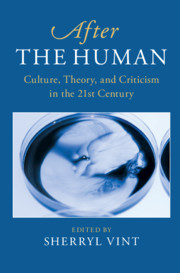Book contents
- After the Human
- After Series
- After the Human
- Copyright page
- Contents
- Contributors
- Acknowledgments
- Introduction
- Part I After Humanism
- Part II New Objects of Enquiry
- Chapter 6 Machines, AIs, Cyborgs, Systems
- Chapter 7 Animals
- Chapter 8 Life “Itself”
- Chapter 9 The Anthropocene
- Chapter 10 The Inorganic
- Part III Posthumanities
- Collective Works Cited
- Index
Chapter 10 - The Inorganic
from Part II - New Objects of Enquiry
Published online by Cambridge University Press: 26 November 2020
- After the Human
- After Series
- After the Human
- Copyright page
- Contents
- Contributors
- Acknowledgments
- Introduction
- Part I After Humanism
- Part II New Objects of Enquiry
- Chapter 6 Machines, AIs, Cyborgs, Systems
- Chapter 7 Animals
- Chapter 8 Life “Itself”
- Chapter 9 The Anthropocene
- Chapter 10 The Inorganic
- Part III Posthumanities
- Collective Works Cited
- Index
Summary
While Aristotle located minerals, metals and other earth matter at the bottom of the hierarchical classification of beings, thus creating an insurmountable gap between the geological and animated ontologies, post-humanist approaches to the inorganic seek to bridge that gap and complicate the Aristotelian hierarchy of beings. Post-humanist approaches to the inorganic include thing-theory, object-oriented ontology, vital materialism and actor-network theory. I zoom onto Catherine Malabou’s concept of plasticity, which she develops in a post-humanist reading of Hegel, and which captures the capacity of organisms and objects to transform their internal parameters in response to the environment. I argue that Malabou’s ‘plasticity’ complicated and subverts the Aristotelian hierarchy of beings. Next, I apply these conceptual insights to ask about the place of non-human agency in collective and traumatic memory; through a close reading of Didi-Huberman’s Bark, I show that materiality and plasticity are aspects of mnemonic affordance
Keywords
- Type
- Chapter
- Information
- After the HumanCulture, Theory and Criticism in the 21st Century, pp. 147 - 158Publisher: Cambridge University PressPrint publication year: 2020
- 1
- Cited by

